SDG 6, a call to ensure we all have acces to water and sanitation
Every human activity is related to water and although this is a way of life, depending on its quality, it can make us sick.
However, the quality of the vital liquid continues to worsen and some of the actions to try to solve the problem, such as promoting a culture of reducing pollutants, applying natural solutions –reforesting basins, for example- and building the optimal infrastructure to give water the treatment it requires, are not carried out fast enough so that the populations are not affected.
In addition, almost 70 percent of the world's wetlands have been lost, which are key ecosystems to maintain the water reserves that benefit all living beings.
“If we do not pay attention to ecosystems and we continue degrading them, we are putting our own survival at risk, because recovering a natural system is much more difficult and expensive than conserving what is left of it,” says Julio Montes de Oca, Livelihoods and Climate Change Unit’s Coordinator at the Regional Office for Mexico, Central America and the Caribbean at the International Union for the Conservation of Nature (IUCN).
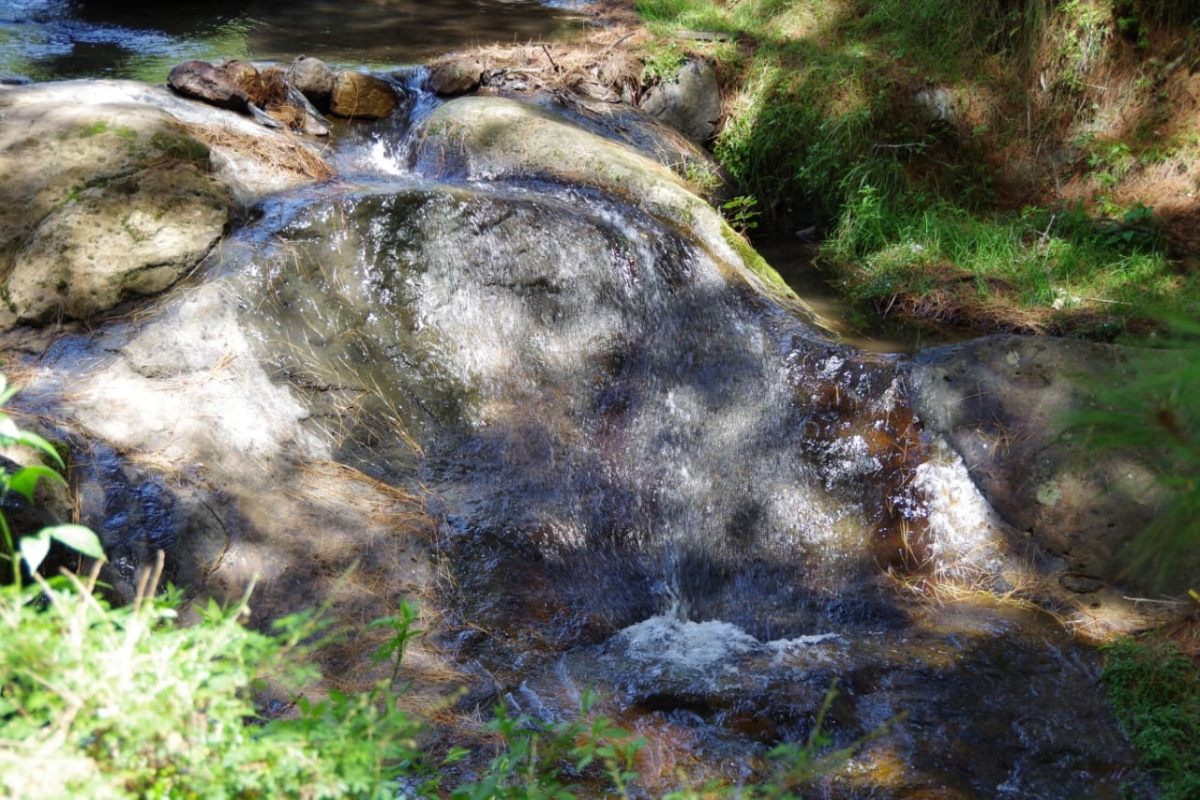
A crystalline stream runs through Paraje Chuipachec, in the municipality and department of Totonicapán, Guatemala. Photo courtesy: Julio Mauricio Pineda Marroquín
Besides, not enough is being done to translate the Sustainable Development Goals (SDGs) into social planning processes, policies and strategies, and turn them into tangible actions at local level, points out the Synthesis Report on SDG6 Water and Sanitation 2018 published by the United Nations Agency for Water (UN Water).
And what are the SDGs? They are a universal call for action to end poverty, protect the planet and ensure that all people enjoy peace and prosperity.
There are 17 objectives with 169 goals, which are based on the achievements of the Millennium Development Goals, and include new areas such as climate change, economic inequality, innovation, sustainable consumption, peace and justice, among others.
The SDGs are interrelated and often the key to one's success will impact on another’s achievement. The number 6 is the one related with water and sanitation.
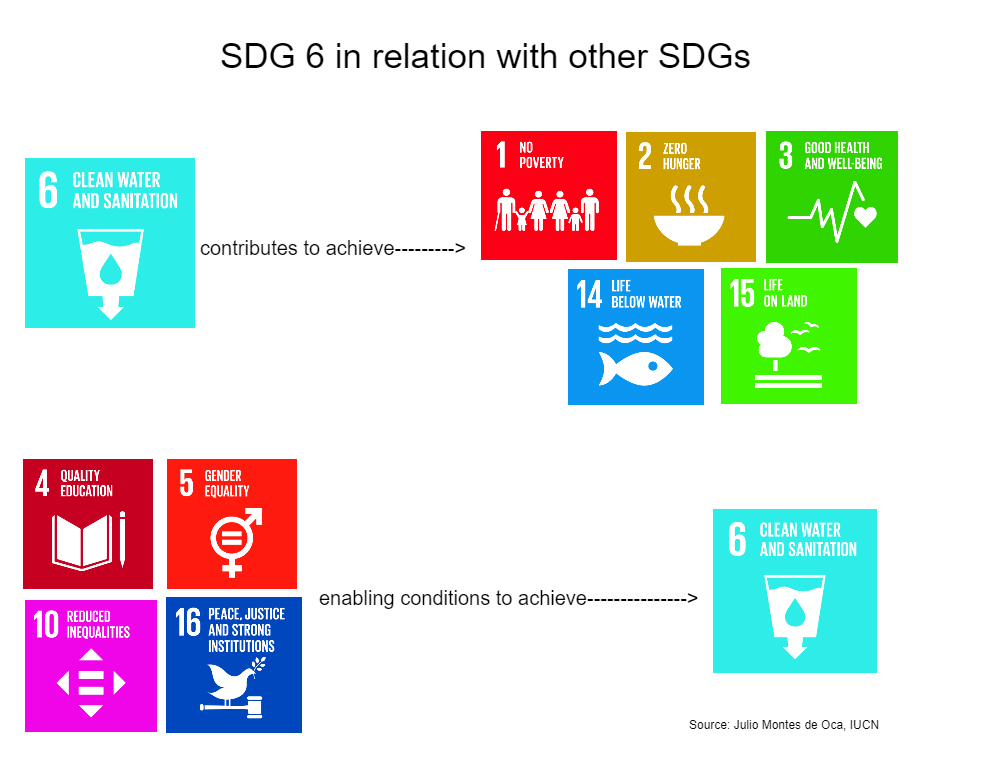
These SDGs derive from the 2015 Sustainable Development Summit, in which the United Nations’ states members approved the 2030 Agenda, which is a global plan of action in favour of people, the Earth and the environment.
However, as indicated in the UN Water report, it is necessary to collect data to inform, make the best decisions and promote transparency and better water governance, the chemical engineer and master in human ecology, Julio Montes de Oca, says during a talk about SDG 6 Water and Sanitation and ecosystems. This subject was taught during the virtual training course for journalists and communicators: “An approach to the objectives of sustainable development with emphasis on water and climate change.”*
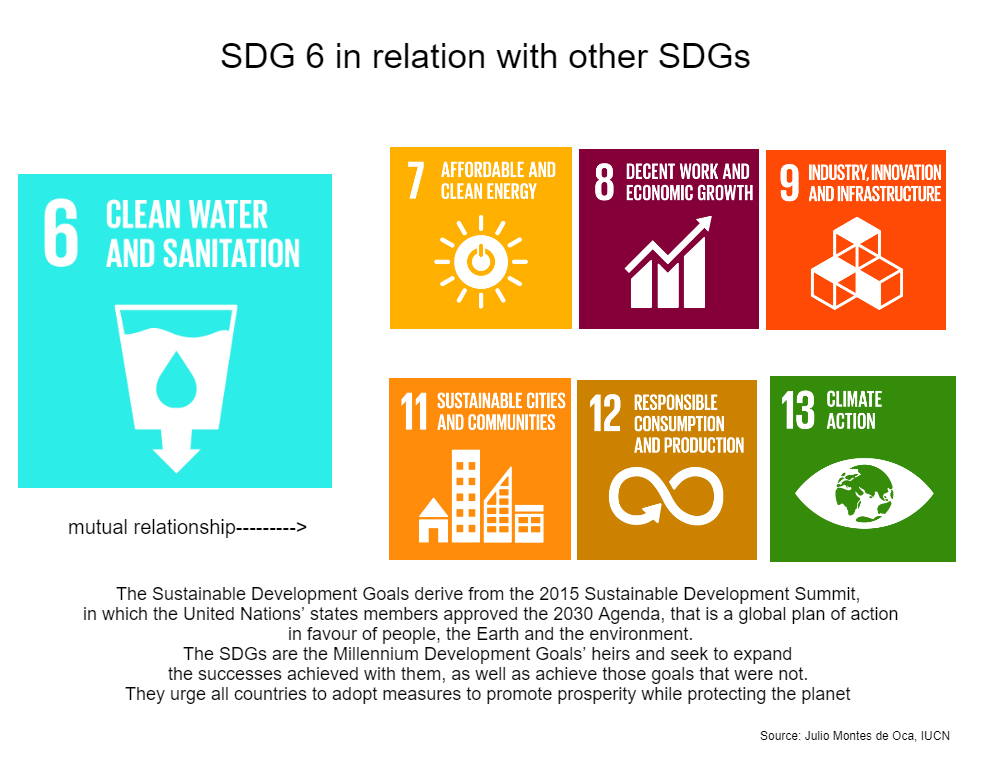
The role of a cleaner production and how it can contribute to the proper use of water
Industry and trade are fundamental for sustainable development and to strengthen the society’s environmental awareness, especially in countries such as Guatemala, where
Government’s structures are not the most efficient, so people seeks the services offered by the private initiative.
In order to make more environmentally friendly the developing countries’ services supply, in 1989 the United Nations Environment Program (UNEP) created the World Cleaner Production Program and encouraged the establishment of specialized centers on the subject. At present there are 65 centers distributed in Latin America; Eastern Europe; Africa, with an Arab sub region; and Asia.
The Guatemala’s one was created in 1999, and from 2007 it was constituted in foundation, through the Ministerial Agreement No. 1345-2007. Since then, it is called the Guatemalan Center for Cleaner Production (CGP+L, by its acronym in Spanish), a non-profit technical reference institution in its field of action; with technical experience in improving the competitiveness and environmental performance of the industrial, public and academic sectors. It has worked with 550 companies that belong to 18 sectors between services and products. It has a cooperation agreement with the Ministry of Environment and Natural Resources (MARN, by its acronym in Spanish) and has developed 45 projects with 15 international cooperation agencies in different areas, its director, chemical engineer Luis Muñoz says.
Customized environmental solutions
The CGP+L's work is like that of a tailor, Muñoz says, because they “tailor” environmental solutions to fit their customers’ needs.
They have also identified the most important variables that companies in the country must improve and have developed tools to offer them the technical solutions they need.
However, they have changed the way they offer that advice. They no longer do so through donations or free of charge, because it does not work. “When the advice is provided at no cost, managers do not get involved or maintain the projects we propose, even if they obtain benefits. But it's different when they pay and get the needed change with their own money,” Muñoz says.
In addition, as the approach of the environmental issue is not only a technical but social variable, Muñoz assures, at the CGP+L they have learned how people think, get inspired and reason to determine the best way to work with them.
Also -as it happens when you want to support urban or rural communities- it is important to talk with the leader, make him a participant in the process that is intended, because if that person does not visualize the benefits, there will be no a behavioral change and he will not authorize the resources availability to implement the improvements.
Responsibility or competitiveness?
According to the CGP+L’s technicians experience although each company and business work differently, what they have in common is that their managers are usually not aware of which or what are their biggest problems.
In the specific case of water, many are unaware of where it comes from and how much they are using in their processes or offices.
Most of them only know that the municipality provides it or that they extract it from a well; enter a tank; it is used in a process and then it goes out. But they do not know the quality in which they discharge it and where it ends, and this ignorance has consequences.
“It is not about they are going to spend all the available water, but if they do not make a sustainable use of it, they could be penalized and even fall into market risk. For example, currently, users have been informed that they must think if it is suitable or not to acquire a product packed in a disposable plastic. Later, it will be water. ‘If you consume this product, ask yourself if the company that manufactures it is using water well’,” Muñoz says.
On the other hand, those who care for water resources do so because it is part of their competitiveness. And we are not talking about saving water, says the engineer, but about knowing its cycle: how it is generated, how much and how it is used, and where and how it is discharged.
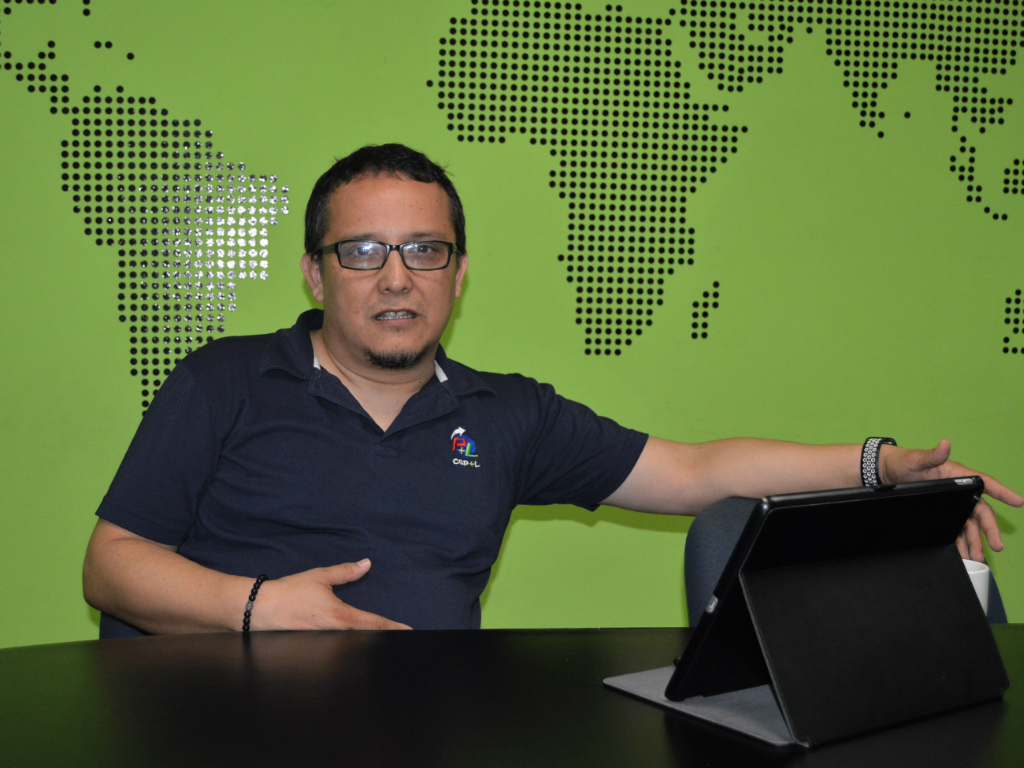
Luis Muñoz, CGP+L's director. Foto: Lucy Calderón/EcocienciaGT
Water audits are essential for environmental management
One of the tools used by the CGP+L to assess the environmental performance of its clients is the water audit. Six years ago they started to implement it and to date they have done 35.
According to Muñoz, 75 percent of the Guatemala’s companies lack the water balances to which the aforementioned audit points; they do not know the water cycle, and almost half of the companies and businesses audited do not have water meters in suitable points, and having them alone at the entrance of the business is not enough, this keeps them at risk.
Although the execution of this audit has been increasing and since 2017 water management represents 20 percent of the CGP+L’s work, something that entrepreneurs need is to be more strategic. If they have their operations located at the capital, why are they reforesting in the department of El Petén, in the North of the country? Why do not they reforest a basin in the capital? Muñoz asks.
Impose a price to water
Entrepreneurs have to be given a reason -redundancy is worth- a business, logic and economic one to care for the environment. “Cleaner production is a tool of competitiveness, economy and environment,” Muñoz points.
However, as long as water is not valued and there is no a well-designed system of distribution, use and final disposal, achieving its rational use will only be achieved through social, legal or market pressure. Of these pressures, the best for a company to develop and be bigger is the market one, he says.
One example is the aforementioned use of plastic, which is why business owners should ask themselves if their service or product causes a waste, if it is being mismanaged and consequently ends up in a river and contaminates it. And when they have the information, they must act and resolve.
What about sanitation?
One of the SDG 6 Water and Sanitation’ goal is that by 2030 water quality will be improved by reducing pollution, eliminating dumping and minimizing the discharge of hazardous materials and chemicals, reducing to half the percentage of untreated wastewater and a substantial increase in recycling and re-use in safety conditions worldwide.
Muñoz indicates that in the administration of wastewater, the biggest problem is with the municipalities, because if they do not have treatment plants or control and monitoring structures to ensure that the companies connected to their distribution and sewerage system comply with treating the water, the pollution problem of surface and ground sources will continue.
Mario Ricorparchí, councilor of the municipality of San Lucas Sacatepéquez, of the department of Guatemala, mentions that the “silver (money)” factor is what affects to build wastewater treatment plants. But there is also a lack of political will and awareness.
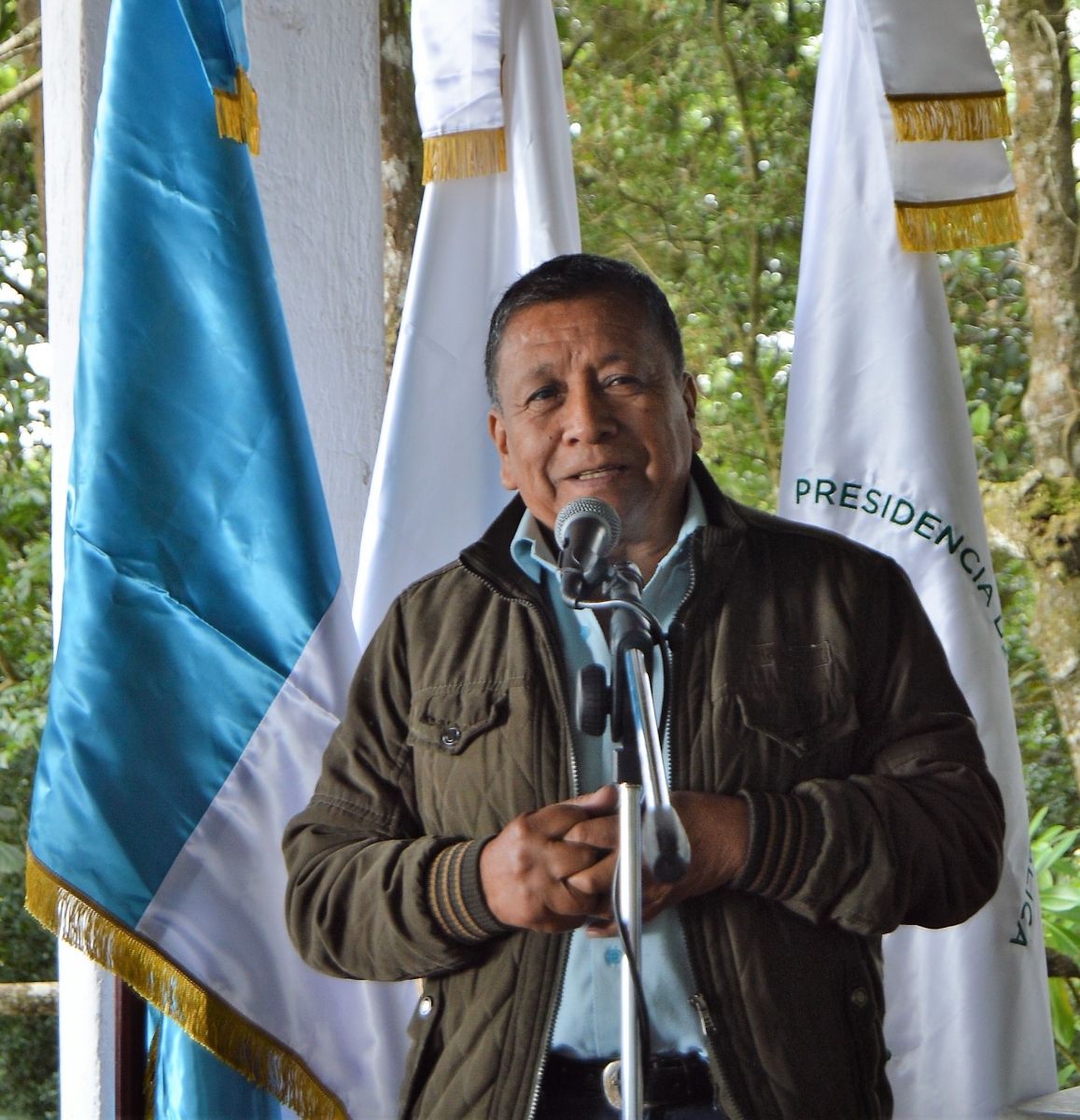
Mario Ricoparchí, councilor of the municipality of San Lucas Sacatepéquez, Guatemala. Foto: Lucy Calderón
“May 2019 is the deadline for the municipalities to have wastewater treatment plants in operation. We have talked about it in the council and thanks God we have the resources. But not all municipalities have the money; one option for them would be to go to international institutions and ask them to help finance these projects”, Ricorparchí suggests.
As for the private sector, progress is being made in complying with Government Agreement No. 236-2006 “Regulation of discharges and reuse of wastewater and sludge disposal”, but public institutions, Muñoz says. “I have participated in technical water tables by the private sector and they are willing to pay and treat it, but in an equitable way. In such a way that if as citizens we pollute the water, we would also have to pay to return it as clean as possible to nature,” Muñoz says.
The professional indicates that large companies are the most supervised and he agrees, but what about micro, small and medium enterprises? And the country's population?
Provide education and advice
Henry López Cifuentes, agronomist, with a master's degree in natural resources, and head of the Climate Change Unit of the Authority for the Sustainable Management of the Amatitlán Lake´s Basin (AMSA, by its acronym in Spanish), says that the industry contributes to the greatest amount of heavy metals that are found in water. In spite of this, Guatemala has the opportunity to enforce the residual discharges regulation to clean up the vital liquid.
“Another fundamental aspect to be fulfilled should be the cleaning up of the water recharge zones, because the wastewater that arrives to them, pollutes them,” he adds. To try to alleviate the situation, AMSA's re-engineering and agroindustry division trains companies established near the Amatitlán Lake’s basin; and since they also have a laboratory where all the analysis required by the wastewater regulation can be done, they advise them on the best way to clean the water they use in their processes.
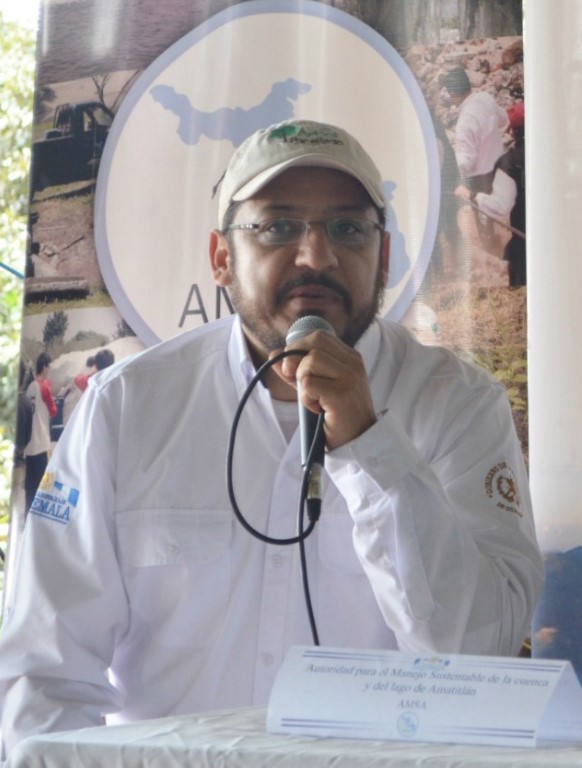
Henry López, head of AMSA´s Climate Change Unit. Foto courtesy: Norma Joj
According to López, it is essential not to focus only on how to generate water in abundance, but also to address the issue of its quality, and if it is suitable for consumption.
“A resource is for a certain population limit or vice versa. According to the 2002 census we are two million inhabitants in the capital and it is estimated that each one of us demands about 150 liters of water per day; but obviously we are more and in the same way, more and more, the potable reserve of the resource is drying up”.
Promoting an environmental culture
The ignorance of the water cycle and the importance of protecting the water recharge zones make people do not change the habits that harm the environment and consequently their health. For this reason, in AMSA they have trained some 3,000 teachers from the schools located near the Amatitlán Lake’s basin, so that they contribute to generating that environmental culture so necessary in children, youth and adults. “The most precious resource that you can own is water and when it is needed due to scarcity or pollution, it will cause a social problem; and although it is important to reforest, it is also important to avoid the continued logging, because in those affected areas trees are no longer being planted, they are given any other use,” López says.

“People must be aware that in addition to us, nature requires water to continue offering us the multiple benefits and services we take advantage of.” Julio Montes de Oca, IUCN. Photo courtesy: Julio Mauricio Pineda Location: Paraje Chuipachec, Totonicapán
To companies, Muñoz recommends generating in its collaborators an environmental culture focused on everyone thinking, understanding and feeling the importance of taking care of resources, not only because nature is beautiful, but because it will provide quality of life and economic wellbeing.
“When the company develops among its collaborators economic and environmental awareness about the value of water, it can have a multiplying effect,” he says.
Because cleaner production seeks to understand how we are in order to improve, company’s leaders have to generate environmental performance indicators; they must relate numbers of how much they consume versus how much they produce; and encourage the greatest number of actions and messages so that their collaborators may take ownership of this information. But while there is a lack of data and businessman do not understand where they are and how they are, they cannot contribute to SDG 6, Muñoz says.
INTERVIEW
The water situation in the most remote and dispersed Guatemala's communities
For civil engineer Luis Enrique Corzo, in charge of the national coordination of the World Vision’s areas of risk, and water and sanitation, it is worrying that having such a large water resource in this country, the surface sources are so polluted. But throughout our history we have not done a good water management, he says, and although the organization for which he works for cannot offer the solution at the national level, because it is not only their responsibility, they can support the populations in those areas where they have incidence, which are quite dispersed and vulnerable.
World Vision has area development programs, with a minimum duration of 15 years. The beneficiary communities are chosen based on their several indicators or initial conditions analysis, such as their malnutrition rate, dropout rates, access to water and sanitation, coverage of basic resources, migration, among others.
Currently, they work in 10 of the 22 country’s departments, and because every five years they redirect their technical programs to the national reality, those that will be implementing from this date to 2021 will cover: food safety and nutrition (being water and sanitation one of its pillars), protection (covering human rights, political advocacy) and life skills (education).
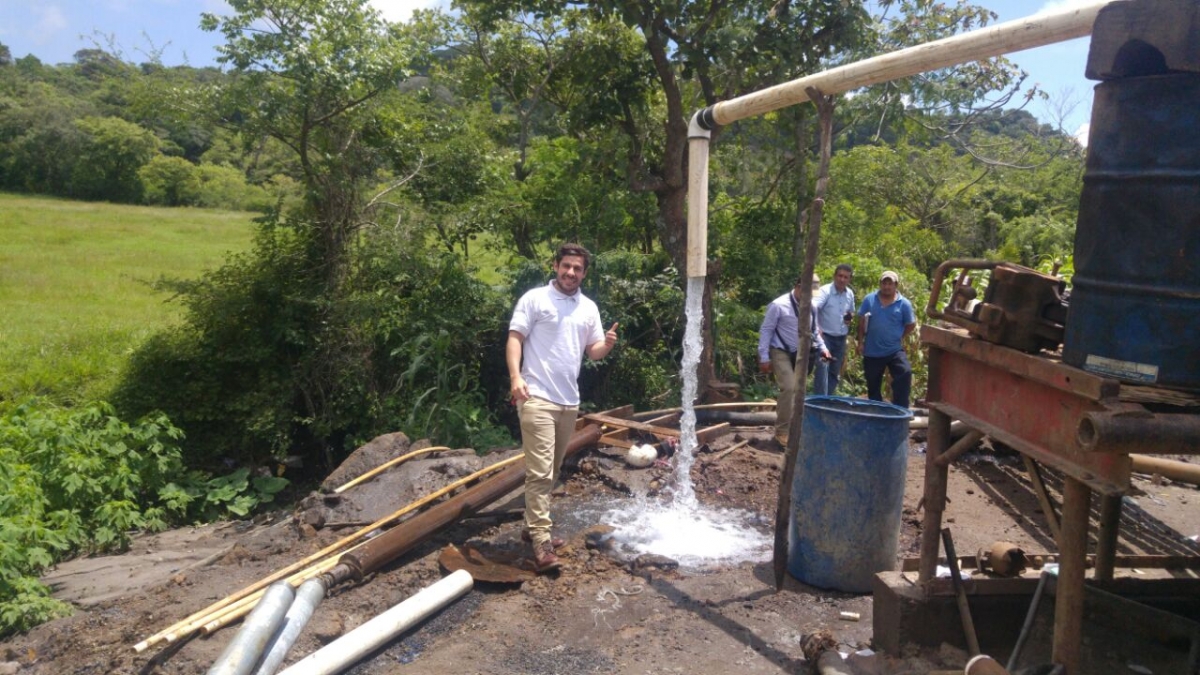
Luis Enrique Corzo, from World Vision Guatemala, in one of the communities where they support the provision of water and sanitation. Photo courtesy: World Vision Guatemala
How does having water and sanitation affect food safety and nutrition?
Food safety and nutrition has four pillars: availability, accessibility, acceptability and consumption, and biological use of food, to which we incorporate the pillar of climate change. And the factors of water and sanitation enter the pillar of consumption and biological use, because both directly affect health. However, in the communities, the highest pollution rates and incidence in diarrheas occur due to the misuse of water. If people were aware of hygiene practices, that rate of diarrheal diseases would greatly decrease. Therefore, in addition to working in the infrastructure sector, we focus a lot on behavioral change.
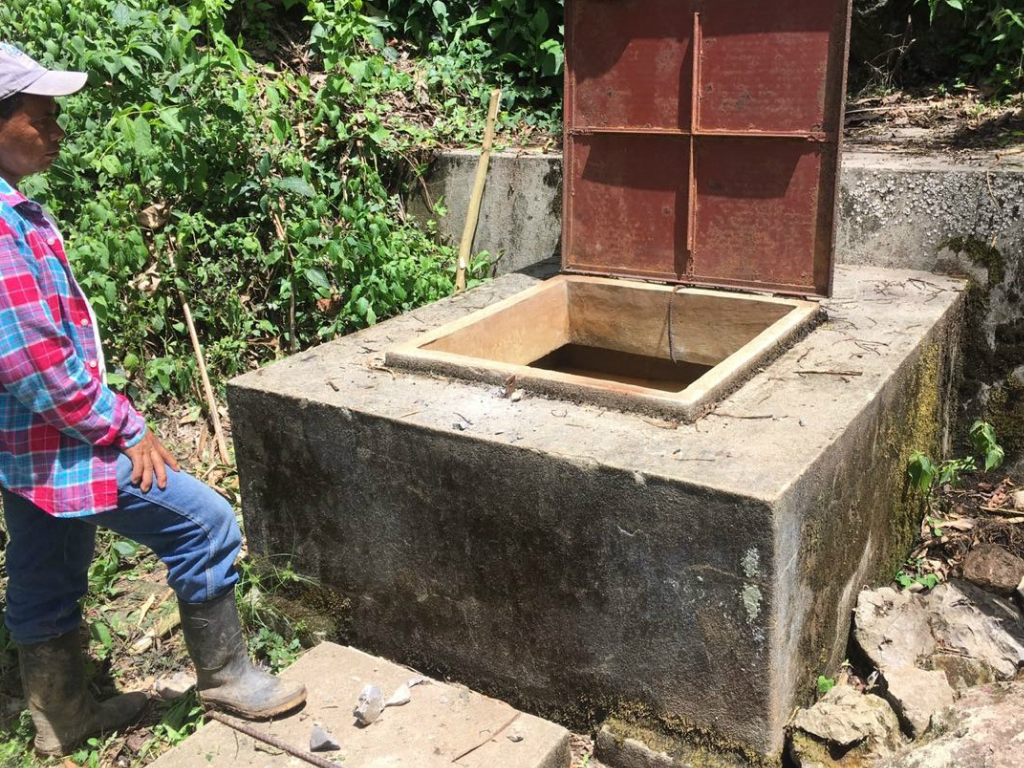
In the municipality of San Juan Ermita, department of Chiquimula, Guatemala, World Vision has supervised the construction of water storage tanks. Photo: World Vision Guatemala
Could it be that one of the problems in the communities where you work is that they do not know how to use water?
In the communities, people sometimes have water, but not at hundred percent; they do not have service all day. In others, its surface sources are not suitable for consumption or are not managed appropriately to make resources sustainable.
We, in addition to providing access to water or increasing the possibilities for them to have it, promote behavioral change. This is so important, because for example, latrine installation projects have been made, and people do not use them because they do not have an appropriate waste management culture.
On the other hand, when we teach to make good use of latrines, we help a lot in the subject of health, which is the goal of bringing them water and sanitation.
Why do the communities do not have water all the time?
First, because they do not have the appropriate storage capacity. Many of its tanks have reduced volume.
Second, they do not have distribution to all communities; many are so dispersed that the services offered by the municipality cannot reach all the houses, and if they do, it is partially.
Third, there are communities very susceptible to climate change due to deforestation and changes in land use.
According to preliminary information from the first assessment report on the knowledge of climate change in Guatemala, the availability of water will decrease in the next 30 years due to a decrease in rainfall and an increase in temperature. How do you think those communities susceptible to climate change will be affected?
The problem is generally that land management is done geopolitically. Therefore, if we continue as we are, that panorama will be reality.
To help change it, we are encouraging people to carry out forest management in an appropriate manner. Many times they have natural resources but do not take care of them as they should; it is the community itself that deforests.
However, when they acquire greater environmental awareness and knowledge of the importance of protecting water sources and recharge zones, they can protect them over time. It is not a change that happens overnight, but you have to start working on it.
Why is it important to know where our water comes from?
The moment I know where my water comes from, I know my surroundings and the conditions that allow that water to exist.
In communities of the country’s dry corridor, as in Jocotán, Chiquimula, the inhabitants are aware of the process of water generation in the mountains, and watch over their care, but they are not all. If they were, it would be easier to generate advocacy on public and departmental policy issues to better manage that resource.
Unfortunately, we lack the ability to know the impact of the domino effect that occurs when a water source runs out. The lack of water limits and forces us to look for other sources that provide it in other places, and thus we exhaust it. But if we all got on the same boat, we could mitigate the effects of climate change and adapt better.
How do you achieve that essential behavioral change?
The first thing to keep in mind is that we will not change a custom that comes from years simply because we believe that we are right or we own the truth. We are just guides that can show a reality.
The processes have to be driven by leaders and community-based organizations; they are in charge of demonstrating to others the reality they are living and what are the ways of improvement using the resources they have.
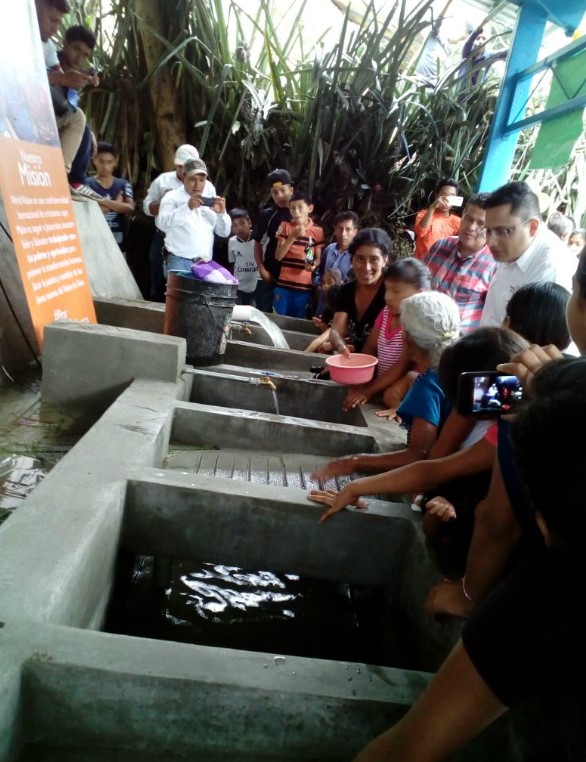
Caserío Ixcanal, municipality of Comapa, department of Jutiapa, Guatemala, where World Vision has also contributed to having drinking water. Photo: World Vision Guatemala
Where have you achieved a behavioral change?
At Ingenio Guaraquiche, in the municipality of Jocotán, department of Chiquimula, where the population is native Ch'orti'. There we support the pipeline restoration of the water they obtain from a mountain in order to distribute it to a slow filtering tank and then redistribute it to each of the houses.
At the beginning, due to various factors, it was difficult to start a conversation with them, especially with the leaders. Then, when the community members realized that the project was progressing, they realized too that sometimes their own leaders hinder progress, so they made a change of authorities.
The new leaders are people who, before we arrived, supported projects of this type. Now they are expanding the water coverage to homes they did not have before. This was an unexpected impact, beyond the original scope of our project that lasted 12 months.
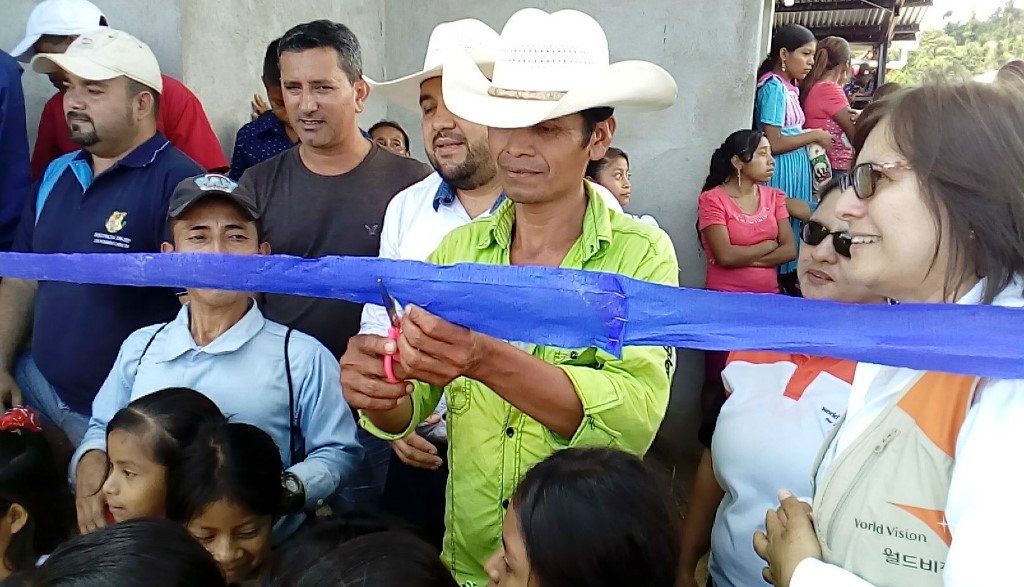
Ingenio Guaraquiche, Jocotán, Guatemala, where it was enabled a water pipeline. Foto: Lucy Calderón/EcocienciaGT
About how water is being returned to nature, what progress have you made?
In these communities, as they are dispersed, many do not have a drainage network and use more traditional waste disposal methods.
There, our greatest action is to teach the correct disposition of excreta and basic sanitation, because doing it incorrectly not only impacts the environment but also food security and nutrition, and people´s health.
How important is for them to learn about water and sanitation?
The first step to work in a community is to visit it, make a diagnosis and participatory dialogue and carry out the survey of geometric, topographic data, among others, to detect their needs and based on them, model the projects.
During this dialogue with people, the topic of water is always afloat, above all because of its lack.
In many of the communities, water does not arrive even once a day; women and children have to walk several kilometers to get a water jug of about five liters capacity and it takes between 30 minutes and 2 hours to go and return; while, men are responsible for working in the field.
So together with the infrastructure issue, we started with educational actions to promote change and women´s participation. They have a great impact on their families and communities’ quality of life.
The knowledge of the water cycle, where does my water come from? is vital to understand that if we contaminate, that pollution will return to us in detriment of our means of life and our health.
By having knowledge and awareness that garbage should not be thrown in rivers, for example, because this generates diseases, people can take better care of their environment. Episodes of diarrhea diminish and as a result there is a better absorption of nutrients, it improves the life’s quality.
Know to value, there is the difference
In all areas, having information is key to generating the appropriate messages and making them known through appropriate channels in order to produce the needed behavioral changes. To achieve this, it is necessary to start generating the data that will be transmitted, engineer Muñoz says; and from education to communicate them, engineer Lopez says.
Having the opportunity to put yourself in the shoes of other people and know their reality is also important. “Before, I only knew from the news that many children live in unsuitable conditions and it moved me, but nothing more. Now that I can see that reality and knowing that with my work I can contribute to benefit the most vulnerable is different,” Corzo says.
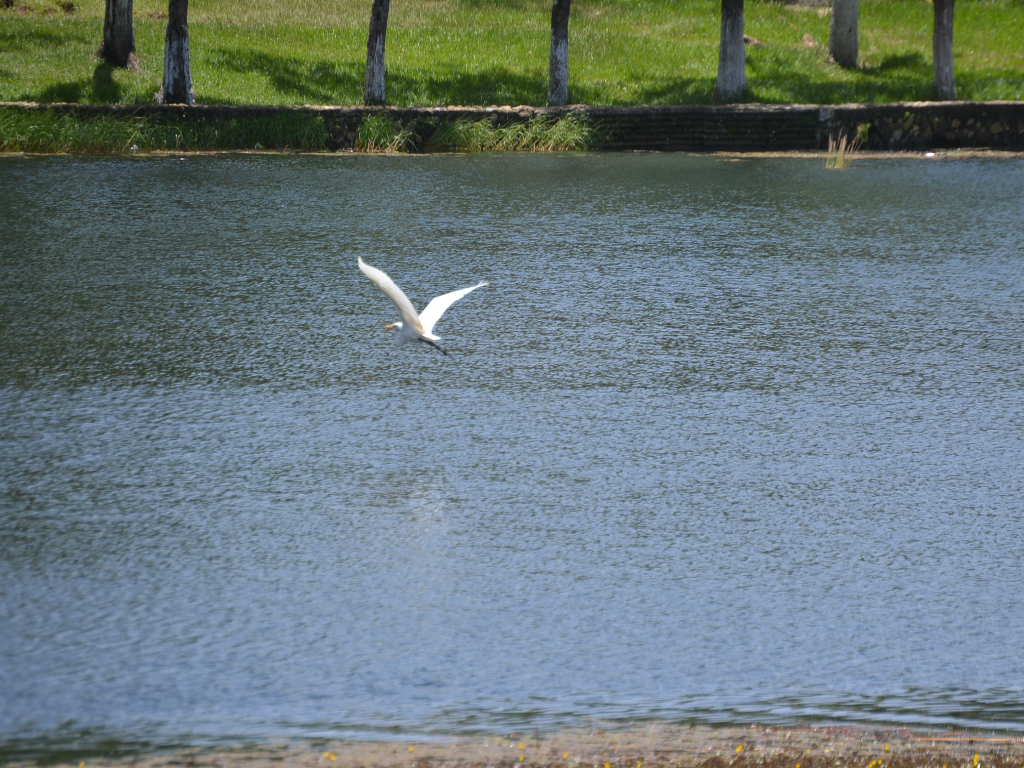
Laguna El Pino National Park, in the municipality of Barberena, department of Santa Rosa, Guatemala. Photo: Lucy Calderón / EcocienciaGT
Therefore, to address the SDG 6 call on Water and Sanitation, it is necessary to offer understandable and useful information, according to the needs and responsibilities of society’s sectors with which we work. Only then people will take ownership of the theme, understand that conserving nature is an investment and that acting around the supply and care of water, goes beyond just installing keys and pipes.
*The aforementioned virtual course was held from May 15 to July 24, 2018. It was led by Global Water Partnership Central America and the Communication Network on Climate Change (LatinClima), with the support of the Auraclima Program of the Spanish Agency for Cooperation International (AECID, by its acronym in Spanish) and the Ministry of Environment and Energy of Costa Rica (MINAE, by its acronym in Spanish), through the LatinClima Project and the support of the Earth Journalism Network of Internews and the Tropical Agronomic Center for Research and Teaching (CATIE, by its acronym in Spanish).

Add new comment